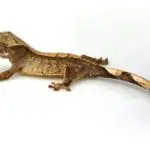Lizards are very popular pets, and this is because these creatures are easy to keep, require very little maintenance, and are also very friendly. But just like people, some lizards are better off as pets than other kinds. Also, some lizards may not be good pets to keep and may have some potential disorders. Here are seven well-known species.
Bearded Dragons
Bearded dragons are very popular pets. These are moderately-sized lizards that are from Australia. These are known to be good pets, especially for first-time reptile owners, but may require experienced care and attention, especially when it comes to its nutritional needs.
A bearded dragon can live from 6 to 10 years and can grow from 16 to 24 inches. Meanwhile, some bearded dragon species can live longer than 10 years and may also grow larger than two feet in length, especially when in captivity.
Potential disorders
The diet of bearded dragons is mostly crickets in the wild, but in captivity, this lovely lizard can eat other insects plus fruits and vegetables. When it comes to potential disorders that can plague this pet lizard, it is known to be susceptible to digestive impaction when its diet is mainly crunchy insects or bugs. This may also suffer from metabolic bone disease, a condition that causes lizards to have no control over their legs. The most common cause of the metabolic bone disease is poor calcium and lack of vitamin D3.
Bearded dragons with a metabolic bone disease cannot walk, move, or play like ordinary lizards. These live in pain as every movement can be an excruciating activity for them. It’s important to detect metabolic bone disease early so your lizard can still respond to treatments.
Chameleons
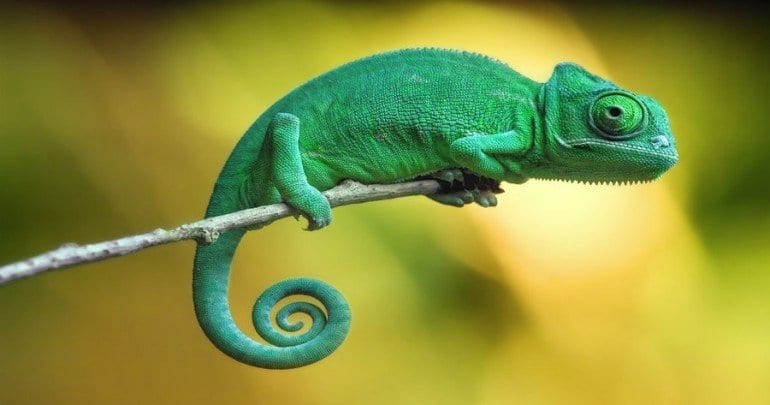
Another very popular lizard is chameleon. It is an amazing creature with unique qualities and a challenging temperament. Chameleon’s care needs are very specific since this lizard can become stressed easily.
Chameleons are also naturally territorial and are solitary creatures; therefore, you must keep each lizard in individual cages or enclosure to prevent fighting. Chameleons can live up to 10 years or more, but you must be careful since fighting for territory can be fatal and can even lead to death.
Young chameleons are colored gray or brown and may have the ability to change colors only for a few short whiles. But as these lizards grow and reach their fifth month, they can now change colors and may have developed new colors like green, turquoise, blue-green, and black.
The ability of chameleons to change colors is a way for them to evade predators. They can blend well with their surroundings so that predators like birds and snakes can mistake them for other things in the background. Changing colors is another way to regulate temperature with darker-colored chameleons trying to regulate their temperature during hot days. And finally, chameleons use their ability to change color as a way to communicate with other chameleons. So basically, dull-colored chameleons may be stressed while brightly-colored specimens are happy and healthy.
Potential disorders
Chameleons may suffer from calcium and vitamin A deficiencies, and mostly, this is due to an unhealthy diet. With these problems, a chameleon can develop bone problems, which can affect the way they walk, move, and interact. It’s important to monitor the health of your lizards against bone problems and calcium imbalances to treat these conditions early.
Another common disorder in chameleons is mouth rot or simply an infection that occurs in the area around the mouth. This could be due to many things, including fights and poor cage maintenance. Mouth rot has symptoms like redness, excessive saliva or drooling, and lack of appetite.
Improving your chameleon’s diet is important to prevent nutrient deficiencies and other health conditions. Also, don’t forget to contact a reptile vet to treat any of these conditions ASAP.
Gila Monster
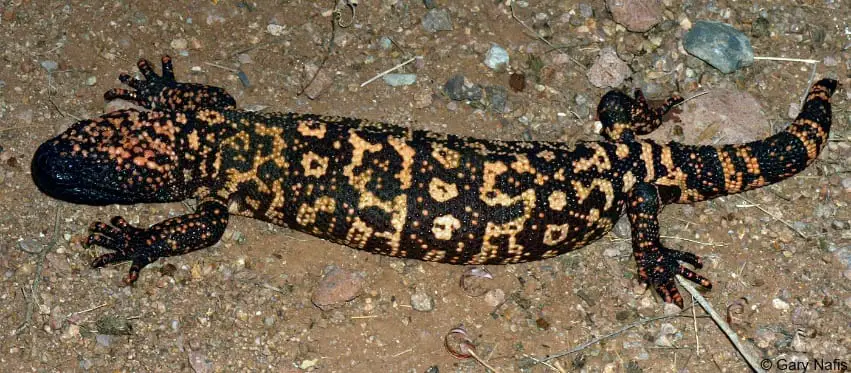
A Gila monster is one of the largest lizards that are from the United States. The name is from the Arizona Gila River basin, where these lizards roamed free. It is a venomous lizard and should be handled with great care. The Gila monster has a large stout body and can weigh up to 4 pounds.
Gila monsters are carnivores, which means that these will only eat meat. These lizards are lazy and would rather prey on small mammals and eggs mammals. Gilas eat worms, carrion, lizards, rodents, insects, and frogs.
Other unique facts about this lizard are that these use their venom to paralyze its prey and eat it. These lizards are covered by bead-like scales called osteoderms, and these are mostly brightly-colored. Experts say that this is one way for the lizard to warm predators, which is similar to the bright colors of poisonous dart frogs. Also, Gila monsters have a very large and long tail, and these are usually used to balance themselves as they walk.
Potential disorders
Gila monsters are ideally healthy and can live for many years because these creatures are at the top of the food chain. But it is also possible for Gila monsters to suffer from metabolic bone disorders, which is a condition where the lizard is unable to walk and have poor motor coordination due to low calcium levels and vitamin D3.
It is also possible for this giant lizard to suffer from mouth rot and infections because of its wild nature and when it eats dead animals like carrion. Mouth root and oral infections may go untreated, and this can cause inflammation and pain.
Agama Lizard
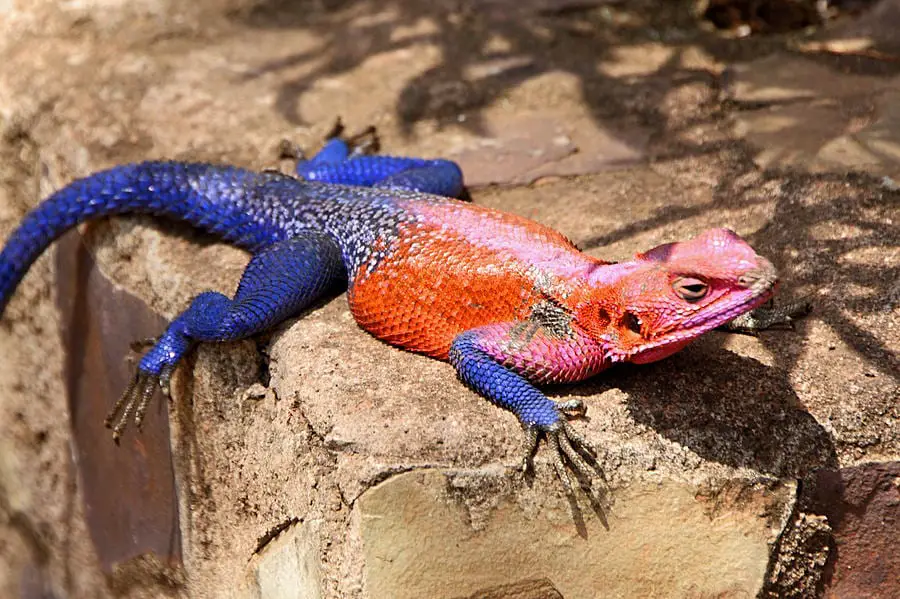
The Agama lizard is native to sub-Saharan Africa. Also known as rainbow lizards, these can live in urban or suburban areas and also the wild areas where it can hunt for insects and eat vegetation. The Agama is characterized by a whitish underside and a buffed brown limbs and tail. These lizards may have a blue body and yellowtail and head, which is easily seen in dominant male lizards.
The Agama lizard is docile, but some males defend their territory. This lizard basks between ten and noontime; therefore, an Agama may have a darker dorsal color during the later hours of the day. When it comes to diet, the Agama is an insectivore and may eat small reptiles, small mammals, and sometimes vegetation such as flowers, grasses, and fallen fruits.
Potential disorders
The Agama is a healthy lizard breed and is known to live a happy, healthy, and long life in captivity, but these are not immune to some very common lizard illnesses like metabolic bone diseases, mouth rot, and nutrient problems.
When kept in an enclosure with other lizards, an Agama lizard can fight for territory, and usually, these fights don’t end well. Some lizards suffer from injured limbs and scratches or bites near its mouth. These injuries can be fatal, causing inflammation and infection. If these are not treated right away, your pet can lose a limb or can develop mouth rot.
Meanwhile, just like other lizards, an agama lizard can develop the metabolic bone disease, which is a disease that stems from poor calcium in the diet and inadequate UV lighting from the lizard’s cage. If this worsens, your pet will have a difficult time standing, walking, or moving around. The key to the treatment of metabolic bone disease is early detection. Treatments usually center around improving calcium levels and placing the lizard under a UV light. Late stages of metabolic bone disease are irreparable and can also lead to the death of lizards.
Studies on the viruses that affect reptiles found that the agama lizard and other species are susceptible to many forms of parasites. This is true, especially for wild-caught lizards. Agama lizard’s environment plays a crucial role in the development of parasites. When its environment is polluted, or there’s poor husbandry, it’s possible that your pet can be affected by viruses and bacteria that can cause dangerous diseases to humans.
And the key to preventing these diseases is to maintain good cage maintenance and proper handling techniques. Despite being careful, you can introduce parasites and pathogens in your lizard’s cage if you’re not careful. So consider placing a new lizard under quarantine and under close watch for at least a month before introducing it to its new home.
Komodo Dragon
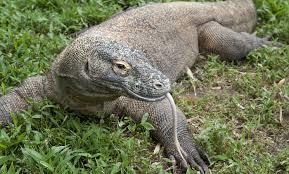
The Komodo Dragon is known as the largest living lizard. It has massive and flat heads, bowed legs, and very thick and long legs that they use for balance as they walk. The name Komodo dragon came from the myth that it originated from the island of Komodo in Indonesia. It was known as a mythical lizard in the western world until a scientist saw the very first Komodo dragon in 1912. This was known as a beast and was called “land crocodile” or “ora” by local townsfolk.
The average size of a Komodo is from 8 to 9 feet and can weigh up to 200 pounds. Some specimens can reach up to 10 feet in length. The female of the species is smaller at only 6 feet but still a huge land lizard that can be very frightening to come across with.
Komodo dragons can be in a variety of colors like green, gray, orange, and blue. They have rough skin that’s durable and reinforced with osteoderms or bony plates or scales all over their heads. You can easily see a Komodo dragon’s claws as they are large. Their tails can whip a large animal and cause severe injuries.
What people don’t know is that Komodo dragons have excellent vision. This lizard can see up to 985 feet or 300 meters. They are also fast despite their large and bulky appearance. They can run up to 20 kph; however, they prefer to hunt stealthily. Usually, these cunning lizards will lay still and wait for their prey in a bush until the animal crosses their path. They will ambush their prey and kill them instantly with their large claws and their ferocious bite.
Another amazing fact about the Komodo dragon is its impressive sense of smell. They are like snakes as they use their forked tongues to taste the air. They will touch the roof of their mouth with their tongue since this is where their special organs are located. The left part of their tongue is for concentrated smells, so the Komodo dragon will know that its prey is near its left side.
Komodo dragons are fierce hunters and will eat only meat. They can eat from the smallest prey to the very huge, like a deer, pig, buffalo, carrion, and humans. These creatures may even eat smaller dragons. According to experts, they can eat up to 80 percent of their body weight in one meal.
The Komodo dragon is known for its unique way of killing prey. They will sneak and knock their prey, overusing their large feet. Then, they will bite the animal using their serrated teeth until this is dead. If the prey survives, the dragon will still be able to eat it later. The prey will die in less than 24 hours because the saliva of the Komodo dragon has deadly bacteria. As soon as the animal dies, the Komodo will come after it and will then finish it. It is still undetermined if the saliva of the Komodo dragon is venomous.
Potential disorders
As far as most conservationists are concerned, there is no threat to the Komodo dragon. It is a vicious creature that’s on the top of the food chain. If there would be anything that can affect this dragon would be small pests like mites and ticks, which suck animal’s blood. Venomous snakes are commonly affected by these pests and have no ways to defend themselves.
The International Union for Conservation of Nature has placed the Komodo dragon in the vulnerable category. According to the World Animal Foundation, the number of Komodo dragons in the wild is estimated to be 6000, and this number is divided among the many islands in the region. These animals remain protected within the Komodo National Park area.
Gecko
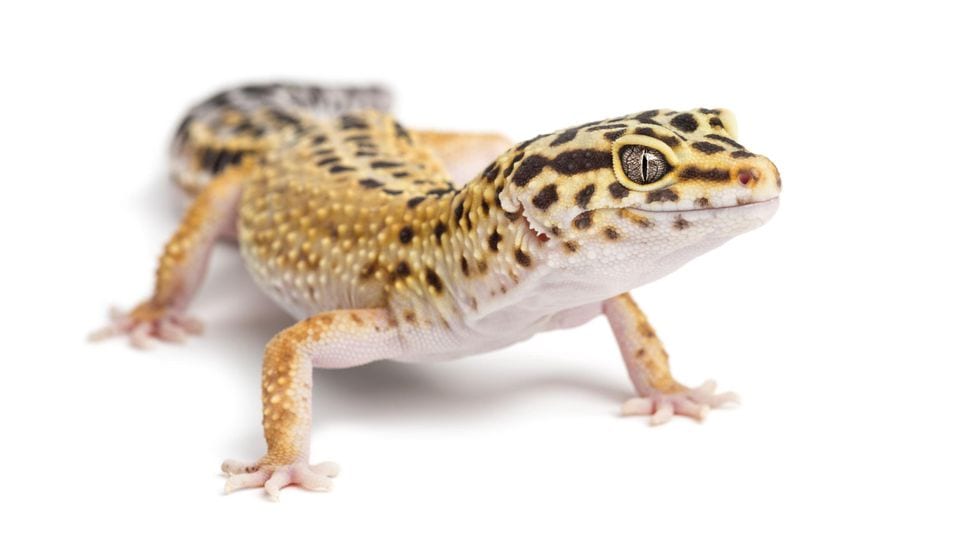
The gecko is small to a medium-sized lizard that is common in most warm areas in the world. There are more than 1600 different species of geckos, but most of these are not kept as pets. Geckos are known to live up to 20 years with those in captivity living the longest. Geckos are among the smallest lizards, and thus, it has become the most popular lizard pets. Just among the most popular are leopard geckos, tokay geckos, day geckos, crested geckos, African fat-tailed geckos, and the common house gecko.
Despite the variety of geckos available, some of these have similar temperaments and behaviors. For instance, most geckos are pleasant and docile animals, but some do not want to be handled by humans since this can stress them out.
Most geckos are active at night, so they come out of their burrows, hunt, mate, and eat during nighttime. Some make chirping noises, especially when they are defending their territories, while some can be very vocal like the Tokay gecko.
Geckos are not aggressive unless you place two males in one cage or enclosure. It is common practice for pet owners to separate male geckos from one another to prevent fights. Other noticeable behaviors in geckos are nodding and moving their tails, which are displayed during courtship and mating.
Geckos eat mostly insects like mealworms, waxworms, crickets, and super worms. There are some species that eat fruit. In captivity, the food of geckos depends on their age and the species. Feedings can be daily or on a weekly basis.
Potential disorders
Geckos are very healthy but are not immune to common health problems that affect lizards. Geckos can develop stomatitis or mouth rot, which is usually due to dirty, unkempt tanks. Early treatment can prevent the worsening of this illness. If you spot reddish discoloration around the mouth with some pus, then you must take it to the vet at once.
Geckos are also vulnerable to respiratory problems. If you see one wheezing or drooling saliva, then it may have respiratory issues, and usually, poor tank temperatures and humidity are the common causes. Parasites internally and externally can also affect a gecko. Geckos can have worms and eggs in their intestines, and mites can be present on their skin. If you see a rash or your lizard has problems with shedding its skin, then suspect external parasites. And if you notice a lack of appetite and changes in its feces, then intestinal parasites could be a problem.
As with all types of lizards, early detection can help save the life of your gecko. Take your pet to an exotics vet for proper care.
Skink
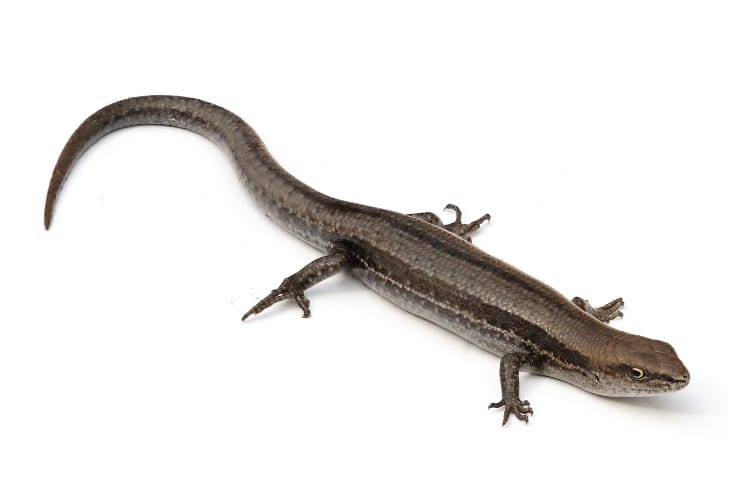
The skink is a large, diurnal creature that has a huge appetite for snails and slugs. It is native to Australia and is a favorite pet. It is easy to care for and is low-maintenance; therefore, a good pet for beginners. Skinks can live up to 20 years or more when properly cared for in captivity. These lizards can grow up to 20 inches, and a colorful species have large, blue colored tongues.
In the wild, skinks like the blue-tongued skink can be docile, but when threatened can display their blue tongues and puff their bodies out. They may also hiss and create terrible noise that can drive predators and humans away.
But when cared for in captivity, these are very docile and will rarely hiss or threaten its owner or other pets. The skink has an elongated body, the shape of a snake. If you pick one up gently, it will allow you to pet it and stroke it.
Nevertheless, do not provoke a tame skink. Teach kids to be gentle with it, treat it kindly. If this is provoked, it can bite, but the bite is non-venomous.
Skinks will eat plants and animals. It will eat vegetables like parsnips, carrots, squash, green beans, and leafy greens. It can also eat fruits like strawberries and melons. When it comes to meat, it will readily eat super worms, pinkie mice, and dog food (low-fat variety).
Potential disorders
The most common health problems of skinks include metabolic bone disease, which can affect their gait, movement, and development. This condition occurs when the calcium levels in the body are very low. Supplementing with calcium is important in a skink’s diet.
This lizard may also suffer from vitamin A deficiency, and supplements are available to fix this. Vitamin A deficiency can affect the lizard’s respiratory system, its skin, and its ability to shed. Skinks can also be vulnerable to intestinal and external parasites. They may harbor eggs of parasites, and these are excreted through their feces. If a lizard becomes less active, has poor appetites and may have changes in its dropping then suspect parasites in the intestines. Meanwhile, ticks, mites, and fleas can lodge in the skin of a skink and will suck the blood from these lizards. Soaking your pet in warm water can help dislodge these pests.
As with all pets, take a pet skink to an exotics vet for proper care. Most pet owners are tempted to use remedies to help our pets, but this won’t do with an exotic animal like the skink.
An exotics vet can help you and your pet out
Pet lizards are not very common in vet offices simply because the owners are not as attached to them as they are with their pet cats and dogs. But pet lizards need help as well. You must monitor your pet’s daily activities, its appetite, and any problems with shedding. Usually, most potential disorders or illnesses are preventable with proper cage maintenance and husbandry. Each lizard has its own living requirements, and you should learn about this before you get one. Also, don’t underestimate supplements because something as simple as calcium supplements can go a long way, especially when your lizard is vulnerable to metabolic bone diseases. Do not take chances; take your pet to an exotics vet at the first sign of illness.



